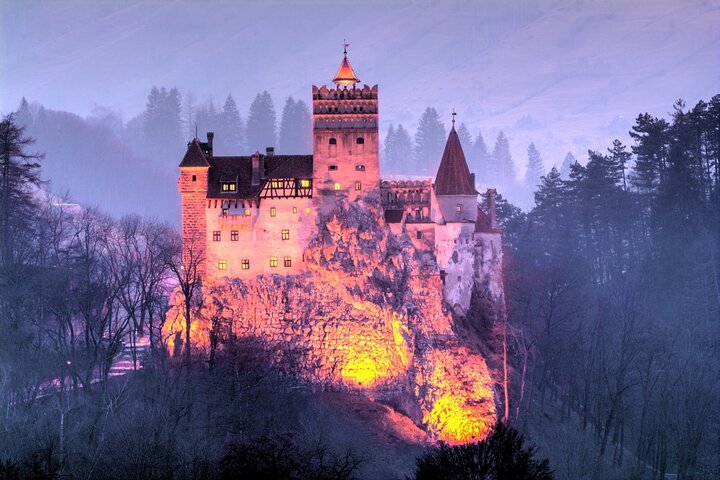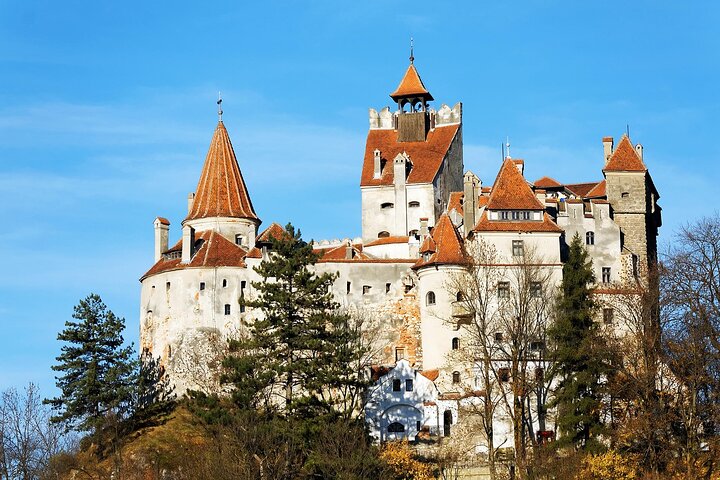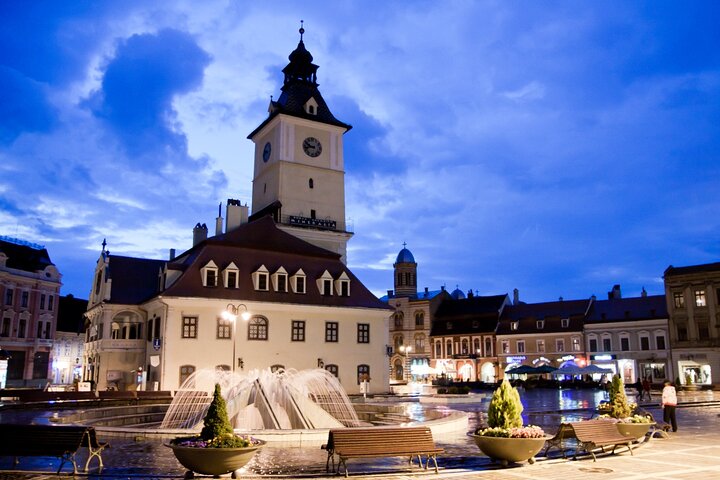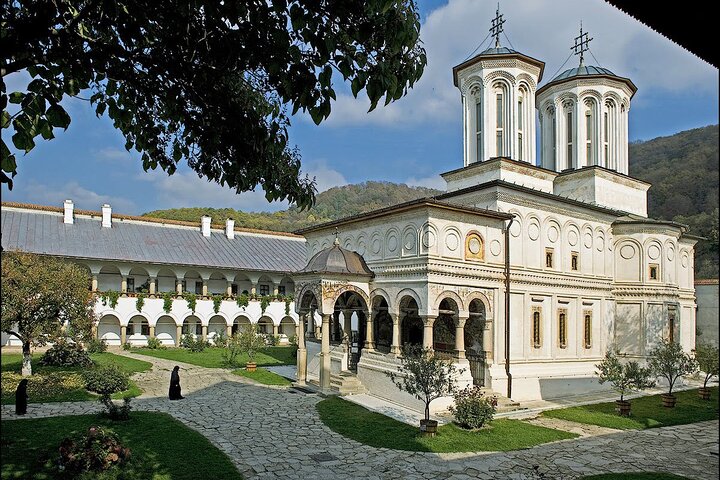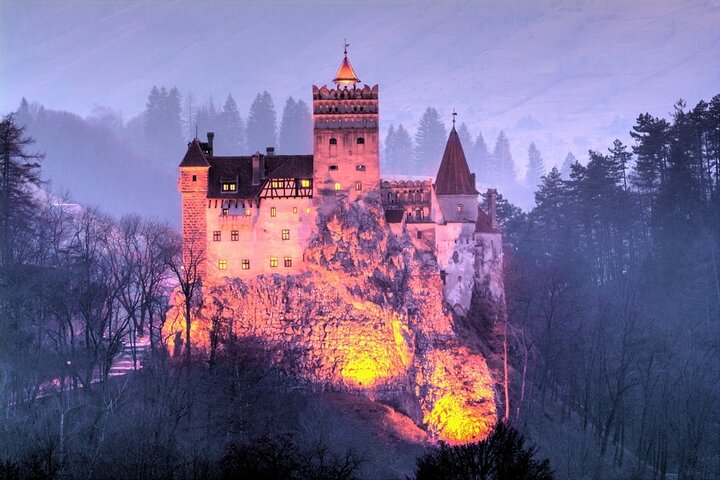Embark on a 9-day private tour in Romania and immerse yourself in the country’s medieval sites, diverse flora and fauna, and delectable local cuisine. Experience the adventure of a lifetime with a local guide!
Embark on a 9-day private tour in Romania and immerse yourself in the country’s medieval sites, diverse flora and fauna, and delectable local cuisine. Experience the adventure of a lifetime with a local guide!
Bucharest City Tour - Overnight in Bucharest
Palace of Parliament - During a day trip in Bucharest, visitors can explore one of the most debated administrative buildings globally. This private tour of The Palace of Parliament, also known as the People’s House, offers insights into the dangers and destruction a totalitarian regime like communism…
Bucharest City Tour - Overnight in Bucharest
Palace of Parliament - During a day trip in Bucharest, visitors can explore one of the most debated administrative buildings globally. This private tour of The Palace of Parliament, also known as the People’s House, offers insights into the dangers and destruction a totalitarian regime like communism can inflict on a nation. Standing before one of the world’s largest constructions, visitors will feel dwarfed by the senseless opulence and megalomania that “the sleep of reason” can produce.
Capturing a selfie up-close is challenging, as visitors attempt to photograph the second-largest administrative building on the planet, after the Pentagon, creating a memorable experience to share with future generations.
Muzeul National al Satului “Dimitrie Gusti” - This private tour includes a visit to The Bucharest National Village Museum, showcasing Romanian traditions and illustrating how Romanian villagers created an ecological and sustainable environment in their backyards. Visitors will also gain insight into their simple and modest lifestyle, living in social and spiritual harmony with their surroundings.
Ateneul Roman - The next stop on the private tour is the Romanian Athenaeum, a significant symbol of Romanian culture and often considered a symbol of Bucharest itself.
Naturally, it is one of the most important tourist attractions on Calea Victoriei and in Bucharest.
Piata Revolutiei - For those planning a city break in Bucharest, The Revolution Square is a must-visit due to its historical significance. Here, visitors can travel back in time to when dictator Ceausescu was overthrown, leaving behind secrets of a great fortune and controversies about the state security service and his offshore accounts.
As mentioned earlier, upon reaching the Senate Palace, visitors will see the building that once housed the Central Committee of the Romanian Communist Party and the site where the Revolution of December 1989 began, a pivotal historical event that led to Ceausescu’s permanent removal from power through human force and sacrifice.
Old Town - A Bucharest day trip offers the chance to relive the past through a blend of mystery and contrasts in the streets of the Historical City Centre, starting with Hanul lui Manuc, a massive fortified inn that served as a cultural and economic hub in its day. Built around 1806 by Manuc Bei, one of the wealthiest landowners in the Balkans, it was a gathering place for merchants passing through Bucharest, part of the vibrant crowd that frequented the historical inn.
In this historical and cosmopolitan area, with guidance from a private guide from Nicolas Experience Tours, visitors will find, in addition to Bucharest’s most popular restaurants, museums, old and spectacular churches, and an experiential library where they can purchase books, music, and other souvenirs for an unforgettable experience for themselves and their loved ones.
1. Curtea de Arges Monastery 2. Poenari Castle 3. Transfagarasan Highway 4. Sibiu City Tour - Overnight stay in Sibiu
Curtea de Arges Monastery - Curtea de Arges is renowned for its significant royal tombs. It is well-known that truly good, beautiful, and enduring things come only through sacrifice, which becomes evident upon reaching the old town of Curtea de Arges. With a rich and eventful history, visitors can see the ruins of the Wallachian princely court, the 13th-century Royal Church, and the famous Arges Monastery, an important historical monument with an intriguing yet somber story.
Poienari Castle - The ruins of Poienari Fortress stand high on a cliff overlooking the Arges River, at the foothills of the Carpathian Mountains. Built at the beginning of the 13th century by the first Wallachian rulers, the castle changed names and residents several times over the decades; eventually, it was abandoned and left in ruins.
Recognizing the location’s potential, upon taking the throne, he ordered the structure to be repaired and fortified, turning it into one of his main fortresses. When the Turks attacked and captured the castle in 1462, Vlad escaped via a secret passageway leading north through the mountains.
Big Square (Piata Mare) - In Transylvania, Sibiu is a must-visit travel destination with a 900-year history. A city tour helps visitors understand why Sibiu was chosen as the European Capital of Culture, including the Evangelical Cathedral, the Sibiu Old City Center, and the town itself, which are among Romania’s most visited tourist attractions, catering to every taste and providing a wonderful travel experience for even the most discerning tourists.
For those who love authentic cultural experiences, whether romantic or adventurous, Sibiu offers everything needed to relax and enjoy, leaving everyday stress behind for a fun and memorable trip.
The beauty of this old citadel, having received record-breaking recognition, stems from its architecture, street arrangement, cultural and artistic heritage, and beautiful natural scenery, as the town is flanked on two sides by the Fagaras and Lotru mountains.
Transfagarasan Highway - Spanning more than 150 kilometers, the Transfagarasan Highway is Romania’s most spectacular and well-known road, and thanks to an appearance on BBC Top Gear in 2009, it is now one of the country’s most popular tourist attractions. Fully open only from June to October, the road’s highest point is at 2042 meters: the tunnel which links the northern and southern sides at Lake Balea (Balea Lac).
1. Biertan Fortified Church 2. Sighisoara City Tour - Overnight stay in Sighisoara
Biertan Fortified Church - The Biertan Fortified Church, a historical monument of breathtaking beauty, was one of the first Transylvanian Saxon settlements in Ardeal, and today it is a UNESCO World Heritage site. Hundreds of tourists visit each year, discovering what makes this place special.
Located in a small town dating back to 1224, the church impresses with its stunning scenery and unique construction – built on a hillock in the center of town, surrounded by three defensive walls and seven bastions.
Sighisoara Clock Tower - The tour of Sighisoara Old Town includes a visit to the Clock Tower and Arms Museum. For those wanting to step back in time and glimpse life in the Middle Ages, Sighisoara, Romania’s medieval town and Count Dracula’s (actually, Vlad the Impaler) birthplace, is a must-visit.
Built in 1280, the Sighisoara Citadel is not only one of Romania’s most visited tourist attractions but also a living, breathing medieval fortress, having remained inhabited for over 700 years – a rarity.
1. Turda Salt Mine 2. Cluj Napoca City Tour (Botanic Garden) 3. Surdesti Wooden Church - Overnight in Sighetul Marmatiei
Salina Turda - Turda Salt Mine is likely one of the most fascinating places to visit in Transylvania. For those vacationing in Romania, it would be a shame not to explore one of its most beautiful sites, the Turda Salt Mine.
This location is a feast for the eyes and the body, as the purifying saline air is especially beneficial for those with respiratory issues, such as allergies or asthma.
Gradina Botanica “Alexandru Borza” - A Cluj Napoca City Tour should be on the itinerary for those passing through Transylvania during their trip to Romania. Visitors should have their cameras ready, as the Old City Center features numerous unique historical and architectural monuments, Baroque, Renaissance, and Gothic-style buildings, the oldest dating back to the 17th century, as well as friendly and welcoming locals.
Not to mention the restaurants and delicious local cuisine, which are so popular that visitors might have to wait in line before getting a table to enjoy their meal.
Surdesti Wooden Church - The characteristic warmth of wooden constructions is unmatched, but the Surdesti church offers much more. Visitors are often so awe-struck they tip their hats – not a joke, considering the church’s towers measure an impressive 54 meters.
Imagine the kind of artwork and craftsmanship that must have gone into this 72-meter high wooden gem, a challenging task even with modern technology, and when considering it was built in 1721, it is understandable why it is considered an architectural masterpiece.
1. Explore Maramures all day (local market) 2. Merry Cemetery 3. Sighet Memorial Museum - Overnight in Sighetul Marmatiei
Merry Cemetery - This trip to Romania promises history, culture, adventure, and fun.
The Dacians, brave and wise ancestors who worshiped the god Zalmoxis, would laugh at funerals and cry when babies were born.
In Maramures, traces of historical continuity remain, most notably in Sapanta, home of the unique Merry Cemetery.
The crosses and tombstones, each a skillful and colorful work of art, feature humorous poems about the deceased that will have visitors in stitches.
Memorial of the Victims of Communism and of the Resistance - To understand why the Romanian people fought so hard to escape communist oppression, a visit to the Memorial Museum for the Victims of Communism is essential. It offers a glimpse into the damaging effects of the totalitarian regime and the immense pain and suffering it caused in a short time.
1. Barsana Monastery 2. Borgo Pass Road 3. Ciocanesti village - Overnight in Gura Humorului
Barsana Monastery - One of the tallest wooden churches in Romania (57m height)
Walking barefoot through the grass connects one to the earth, and stepping into the courtyard of the most beautiful wooden monastery in Romania, the Barsana Monastery, connects one spiritually with the sky and God.
For those who think they have seen astonishing places before, of such divine beauty that they felt they were a piece of heaven on earth, this trip to Maramures might prompt reconsideration.
With its fairytale scenery and timeless history, this magical place has fascinated both tourists and locals for hundreds of years.
Tihuța Pass - Tihuța Pass (Romanian: Pasul Tihuța, also called Pasul Bârgău; Hungarian: Borgói-hágó or Burgó) is a high mountain pass in the Romanian Bârgău Mountains (Eastern Carpathian Mountains) connecting Bistrița (Transylvania) with Vatra Dornei (Bukovina, Moldavia).
The pass gained fame through Bram Stoker’s novel Dracula, where it was termed “the Borgo Pass,” serving as the gateway to Count Dracula’s realm. Stoker likely found the name on a contemporary map; he never actually visited the area.
Today, the pass is home to Hotel “Castel Dracula”; located at an elevation of 1,116 m (3,661 ft), the hotel was built in 1976 and adopted its current name after 1989. The hotel has become quite an attraction due to its architectural style of a medieval villa, as well as the connection to the novel. In 2018, the property was put up for sale.
1. Voronet Monastery 2. Humor Monastery 3. Sucevita Monastery 4. Moldovita Monastery - Overnight in Gura Humorului
Manastirea Voronet - The Voroneț Monastery is a medieval monastery in the Romanian village of Voroneț, now part of the town Gura Humorului. It is one of the famous painted monasteries from southern Bukovina, in Suceava County. The monastery was constructed by Stephen the Great in 1488 over a period of 3 months and 3 weeks to commemorate the victory at the Battle of Vaslui. Often known as the “Sistine Chapel of the East,” the frescoes at Voroneț feature an intense shade of blue known in Romania as “Voroneț blue.”
Did you know that Voronet Monastery was founded by Stephen the Great?
Dubbed the “Sistine Chapel of the East,” it attracts tens of thousands of tourists from around the world every year, having at least three unique elements that make it one of the highlights of a trip through Moldavia and Bucovina.
The most impressive aspect of the church’s artwork, both inside and outside, is the exceptional background color – the famous Voronet blue!
Humor Monastery - To understand the importance of religion to the Romanian people, a tour of Romania is necessary to see the sheer number of houses of worship built and destroyed by enemies throughout history.
Striving to protect their spiritual treasures, people erected churches away from the world’s eyes, some hidden in the depths of the woods, others nestled within rock caves at high altitudes.
Humor Monastery, built approximately 500 years ago, is an example of a fortified monastery that has endured over the centuries.
After the first church here, built around 1400, was destroyed, the second one, built in 1530 with thick river rock walls, was meant to be a place of worship that would withstand the test of time.
Sucevita Monastery - Sucevita and Voronet are two of the most beautiful Romanian monasteries, part of the international cultural and spiritual patrimony, making them essential stops on any trip to Romania and northern Moldavia.
Even for those who have not read the Bible, or the Book of Books, the biblical scenes and icons painted on the walls of the Sucevita Monastery provide stunning and vivid visual support in understanding the history of Christianity.
The fortified church is like an open book for anyone who enters its doors, and only by seeing it in person can one truly understand why it was included on the UNESCO World Heritage list of cultural landmarks.
Moldovita Monastery - For a spiritual journey to a place that still echoes with the fervent prayers of the hundreds of thousands who have found solace here throughout history, an adventure through the Carpathians and Balkans to one of Romania’s oldest monastic settlements, built in 1532, home of the Moldovita Monastery, is recommended.
The fortified church combines elements of Byzantine, Gothic, and Moldavian style, but what truly impresses visitors is its unique mural artwork, both inside and outside this beautiful house of worship.
1. Lucia Condrea - egg painted museum 2. Nicolae Popa Museum 3. Bicaz Gorges - Overnight Stay in Brasov
The Popa Museum - Located 12 kilometers from Targu Neamt, in Tarpesti, Neamt County, visitors can explore the interesting and notable Nicolae Popa Museum. Founded in the ‘70s by local sculptor Nicolae Popa in his own home, the museum is a testament to Romanian values.
After being wounded in World War II, imprisoned by the communists for opposing the regime, and left with only his house, Nicolae Popa stood out for Romanian values. Through hard work and commitment, driven by a strong inclination for art, he became one of Romania’s most valued and appreciated naive sculptors and a true creator of folklore.
Bicaz Canyon - What could be more beautiful than a walk along the banks of a river that has carved its way through the mountains and virgin forests of Romania?
1. Brasov City Tour (Black Church) 2. Bran Castle / Dracula’s Castle 3. Peles Castle - Back to Bucharest
Black Church (Biserica Neagra) - Next, explore the beautifully-preserved medieval town of Brasov, nestled in the foothills of the Carpathian Mountains. A guide will lead a walking tour of the Old Town, revealing the Black Church, the Old Town square, and city walls built in the Middle Ages. Visitors will have free time to soak in the unparalleled atmosphere in one of Brasov’s many charming cafés.
Bran Castle (Dracula’s Castle) - Bran Castle, a blend of myth and history.
Due to its close resemblance to the fictional portrayal of Dracula’s castle, it is widely believed that Bram Stoker used descriptions of Bran to create the fictitious home of Count Dracula.
Outside the castle, visitors can sample an array of traditional foods: handmade cheeses, pálinka (plum and pear brandy), and traditionally-produced ham and sausages.
Peles Castle - Once upon a time, there was a beautiful castle…
For those writing memoirs or wanting to boast about seeing the most beautiful castles in Europe, the Romanian royal family’s summer residence is, by far, one of Romania’s and Europe’s most important tourist attractions, and visitors will soon understand why.
Every year, thousands of important figures and hundreds of thousands of tourists book tours of Romania for this attraction alone, to admire its beauty and, for a few hours, feel like royalty.

- Entrance fees as per the itinerary
- On-board WiFi
- Gasoline included
- Included photo fees
- All applicable taxes and fees covered
- Parking fees taken care of
- Transport in a private vehicle
- Entrance fees as per the itinerary
- On-board WiFi
- Gasoline included
- Included photo fees
- All applicable taxes and fees covered
- Parking fees taken care of
- Transport in a private vehicle
- Accommodation Food and Drinks
- Entrance fees as per the itinerary
- Accommodation Food and Drinks
- Entrance fees as per the itinerary
Experience an unforgettable adventure on our 9-day tour of Romania. We’ve curated a diverse selection of enriching experiences, from exploring medieval landmarks to savoring the untamed beauty of lush forests with their colored wildflowers and crisp mountain breeze (depending on the season). This journey also takes us to contemporary exhibits, and…
Experience an unforgettable adventure on our 9-day tour of Romania. We’ve curated a diverse selection of enriching experiences, from exploring medieval landmarks to savoring the untamed beauty of lush forests with their colored wildflowers and crisp mountain breeze (depending on the season). This journey also takes us to contemporary exhibits, and indulges your senses in the unique blend of traditional herbs and spices in the mouthwatering cuisine we will taste in every ancient town we visit.
Discover Romania and its people in the best way possible - an intimate 9-day tour in Romania with a local guide :) Join us!
For a full refund, cancel at least 24 hours before the scheduled departure time.
For a full refund, cancel at least 24 hours before the scheduled departure time.
